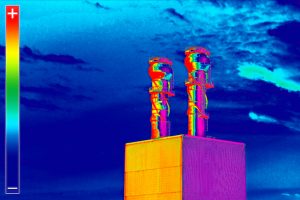Businesses face many types of security challenges; from monitoring multiple sites simultaneously to preventing unauthorized entry, and theft detection. Designing a system to meet the needs of various properties can be complex and costly. This is why the automation and reliability of wide-area monitoring and perimeter systems are critical. With the combination of thermal imaging cameras and radar technology combined with command and control software, businesses can find themselves better protected and more prepared to handle threats.
When combined with other sensors, thermal imaging provides powerful perimeter protection with accurate intrusion classification along with a visual alarm assessment to minimize false alarms.
Thermal imaging uses cameras that ‘see’ heat instead of light. Often referred to as FLIR (Forward looking Infrared) cameras, they produce an image that portrays objects using their core temperature instead of their visible properties.
How does thermal imaging ‘see’ heat? All objects warmer than absolute zero (-273°C/-459°F) emit infrared radiation in the MWIR and LWIR wavelengths (3µm–14µm) in an amount proportional to the temperature of the object. Thermal imaging focuses and detects this radiation, then translates the temperature variations into a greyscale image, using brighter and darker shades of grey to represent hotter and cooler temperatures, which gives a visual representation to the heat profile of the scene. Many thermal imagers can also apply color profiles to these images, showing hotter objects as yellow and cooler objects as blue for example, to make it easier to compare temperatures in the image.
Every manufacturer of thermal imaging cameras has different needs and specifications for the lenses. At Universe Optics, our custom precision lens design provides the optimal solution for your design considerations. From specs, to budget, to your timetable. We understand electrical and mechanical requirements and integrate our lenses into your system with this in mind. Through this approach, custom lens designs from Universe Optics can often reduce system costs by eliminating the need for other design components or modifications.
With the use of thermal imaging cameras, no illumination is necessary. Since thermal energy is naturally emitted radiation, a thermal imager is able to ‘see’ the environment regardless of the lighting conditions. Since this type of passive technology can be used in areas of complete darkness without the need for any light, it’s an extremely covert and versatile solution.
Day or night, the coverage is consistent. A visible camera’s image quality is dependent on good lighting conditions. In areas where contrast is poor or dynamic range is too wide, visible cameras can become rather useless. With thermal imaging, however, the changes in light are irrelevant, and allows for consistency in any lighting environment for a true 24/7 day or night imaging.
Not only for threat detection, the precise temperature sensing capabilities of thermal imaging cameras can be used to monitor equipment in areas like data centers or manufacturing plants to ensure that the temperatures remain safe and trigger an alarm system should it exceed recommended temperature levels.
Thermal imaging even passes through a variety of visible obscurants including light fog, dust, light foliage and smoke. In addition, the precise differences that thermal imaging detects can sometimes reveal objects that may be hiding underneath the surface of other materials or objects. For instance, behind a wall, or objects being concealed under clothing since they affect the temperature of the surface material.
When you factor in the benefits associated with deploying thermal imaging cameras, including accurate detection, sharp imagery, reduced equipment and ease of installation, a strong case is made to apply these cameras for small and large enterprise intrusion detection.